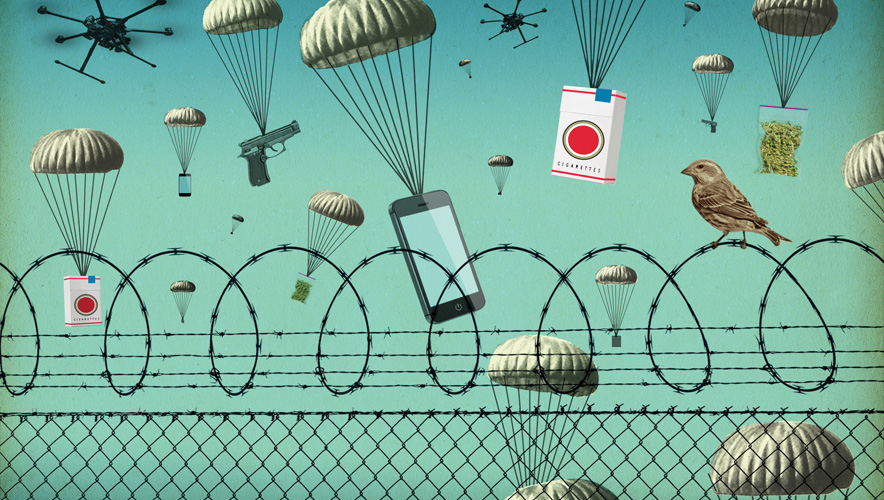The Newest Challenge for Prison Security: Drones
When Bryan Stirling took over as director of the South Carolina Department of Corrections a few years ago, little did he know that one of the trickiest issues he would face in his new role would be trying to keep unmanned aircraft systems (UAS), better known as drones, from dropping contraband into state prisons.
But now, prison officials in South Carolina are in fact dealing with what might be thought of as the 21st century version of a cake with a file baked inside: a drone that is programmed to fly over correction facilities and drop drugs, weapons, or other forms of contraband for inmates. “I would suspect that these incidents are happening all over the country,” Stirling says.
As Stirling notes, when he took over his current position in January 2014, drones were not an immediate concern for most. At the time, Amazon had just begun publicly discussing the possibility of drone package delivery, but company officials estimated that such a practice was four to five years away.
A year later, however, UAS and their related security risks suddenly penetrated the national consciousness when a drone—operated by a drunken off-duty employee of the National Geospatial-Intelligence Agency—crashed on the South Lawn of the White House. “That probably was a wake-up call for America,” Stirling says.
A few months later, it was South Carolina’s turn. One night, a “very alert” correctional officer at a maximum security facility noticed some lights in the air where they shouldn’t be, near a telephone line. It turned out to be a drone, which dropped marijuana and a cellphone charger into the prison. The next morning, prison authorities found a kind of “duck blind,” with Gatorade bottles and other supplies, where those involved in the drone operation could comfortably set themselves up, Stirling explained.
Other such incidents have occurred this year, both domestically and internationally. In May, a corrections officer at the North Central Correctional Institution near Marion, Ohio, found a wrecked drone containing more than six ounces of marijuana, the equivalent of approximately 200 joints, according to The Columbus Dispatch newspaper, which filed a public-records request for prison incidents involving drones. In July, officials at Mansfield Correctional Institution reported that an inmate brawl was caused by a drone dropping more than seven ounces worth of heroin, marijuana, and tobacco into the prison yard. (Ohio corrections officials declined multiple interview requests from Security Management).
Some expect these occurrences to increase, because the drone most commonly used for delivering prison contraband can be purchased online for less than $500. Market forecasters predict that more than one million drones will be purchased in the United States by the end of 2015. In one sense, the problem of drone-delivered contraband is simply the latest iteration of a problem that exploits the fundamental design of prisons—they are designed to “keep people in, not keep things out,” Stirling says.
Over the years, prisons have had to deal with various contraband smuggling schemes, such as mailing in contraband, smuggling it in on trucks, and putting it in condiment jars, Stirling says. Filling the inside of a football or basketball or a fake rock, and throwing it over the wall, has also been tried. At one South Carolina prison, dozens of beehives have been placed in the adjoining woods to keep out the throwers. “It’s been a deterrent,” Stirling says.
But bees and tall walls are no match for a drone. And besides drugs, tobacco, and weapons, drones can transport a good number of cell phones, which prison administrators say pose some of the biggest security risks. Unlike prison pay phones, smartphones are not recorded or monitored. They allow the user to communicate surreptitiously with fellow prisoners and to coordinate with smugglers using drones. There have also been instances of inmates calling local media during prison riots to send photos and relay demands.
“Cell phones are very, very dangerous. I would say they are the number-one problem in prison,” Stirling says. Given their value, they can sell for up to $500 in confinement, he adds.
To fight the new drone threat, correction officials plan to employ several different strategies. In South Carolina, new towers built at some prisons provide better lookouts for spotting UAS, and officials are considering netting to cover the prison’s open top.
Officials are also considering tools that specialize in managed access of phone signals. The federal government does not allow prisons to impose a blanket block on cell phone signals, but a certain degree of managed access is allowed. However, there is still debate over the legalities and privacy concerns about erecting a “geofence” against phone signals. “We need to have a national conversation about geofencing,” Stirling says.
Another approach to prison drone security is being taken by a state legislator, Washington Senate President Pro Tem Pam Roach. Roach says that, as a member of a state UAS task force, she was surprised that members were discussing proper uses for drones, but not the related security challenges they pose. “The issue of security with drones never came up at all,” she says.
Roach, on the other hand, was concerned with the possible security risk that drones could pose to correction facilities. “These prison yards can be very large. Drones can fly in and drop things in like drugs. It’s certainly a big issue.”
And so Roach introduced the Nefarious Drone Enterprise Act. Under the legislation, anyone who is convicted of using a drone to plan or carry out a felony, such as dropping contraband into a prison yard, would automatically have an extra year tacked on to his or her sentence. Last March, the bill passed the state Senate, and Roach says she is confident the House will approve the bill next session, which begins in January.
